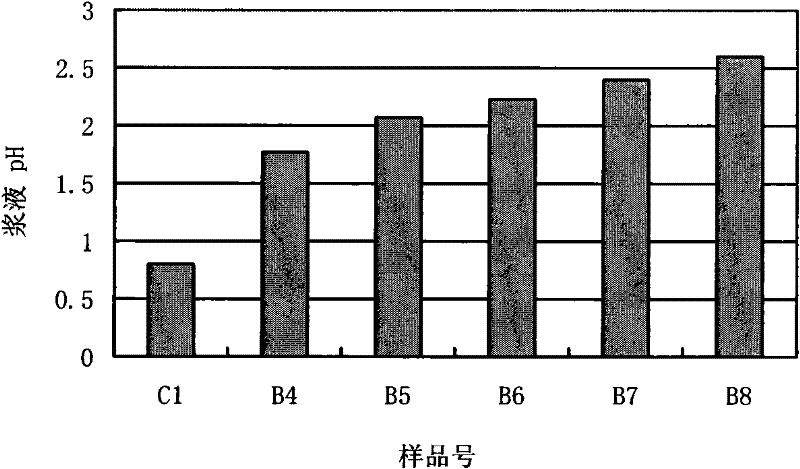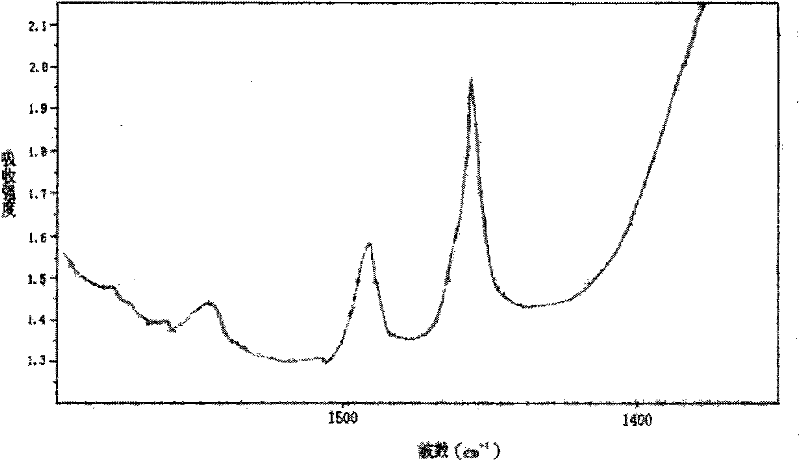Method for preparing modified kaolin with mixed acid
A kaolin, modified technology, applied in chemical instruments and methods, catalyst activation/preparation, catalytic cracking, etc., can solve problems such as consumption, high energy consumption, production cycle, and difficulty in industrial production, and achieve cost reduction and good adhesion performance effect
- Summary
- Abstract
- Description
- Claims
- Application Information
AI Technical Summary
Problems solved by technology
Method used
Image
Examples
Embodiment 1
[0074] Put 500 grams of kaolin A into a 1000 ml quartz crucible, bake it at 650° C. for 3 hours, and cool it down to obtain roasted kaolin A1.
[0075] Get 150 grams (dry basis) of roasting kaolin A1, pour in the enamel reactor that 770g acidic solution (containing the HCl of 4.6wt%, the nitric acid of 0.5% and the tartaric acid of 6.8wt%) is housed, add 80 grams ( dry base) basic aluminum chloride, reacted at 110° C. for 1 hour, cooled to obtain the mixed slurry B1 containing modified kaolin of the present invention, filtered and washed B1, dried, and analyzed the pore structure. The results are shown in Table 3 .
Embodiment 2
[0077] 500 grams of kaolin A are packed into a 1000 ml quartz crucible, roasted at 730°C for 2 hours, and then cooled to obtain roasted kaolin A2.
[0078] Get 100 grams (dry basis) of roasted kaolin A2, pour it into an enamel reaction kettle equipped with 820g acidic solution (containing 10.5wt% HCl and 2.1wt% acetic acid), mix well and add 60 grams (dry basis) of basic formula Aluminum chloride and 20 grams (dry basis) of metal aluminum powder were reacted at 95° C. for 2.5 hours, cooled to obtain the mixed slurry B2 containing modified kaolin of the present invention, dried after filtering and washing B2, and carried out pore structure analysis , the results are shown in Table 3.
[0079] Table 3 Characterization results of pore structure
[0080]
[0081] It can be seen from the data in Table 3 that the modified kaolin prepared by the present invention has a large pore volume, especially a relatively high proportion of medium and large pores.
Embodiment 3
[0083] 500 grams of kaolin A are packed into a 1000 ml quartz crucible, fired at 870° C. for 1 hour, and then roasted kaolin A3 is obtained after cooling.
[0084] Get 380 grams (dry basis) of calcined kaolin A3, pour in the enamel reactor that 600g acidic solution (containing the HCl of 28wt% and the oxalic acid of 3.5wt%) is housed, react at 115 ℃ for 1.5 hours, cool, make this For the invented mixed slurry B3 containing modified kaolin, B3 was filtered, washed and dried, then aged at 800°C and 100% water vapor for 6 hours, and the pore structure of the samples before and after aging was analyzed. The results are shown in Table 4.
[0085] Table 4 Pore structure characterization before and after aging
[0086]
[0087] As can be seen from the data in Table 4, the pore structure of the modified kaolin prepared by the present invention shows good hydrothermal stability, and the pore volume retention rate after aging reaches more than 70%, especially the large pores in the mod...
PUM
 Login to View More
Login to View More Abstract
Description
Claims
Application Information
 Login to View More
Login to View More - R&D Engineer
- R&D Manager
- IP Professional
- Industry Leading Data Capabilities
- Powerful AI technology
- Patent DNA Extraction
Browse by: Latest US Patents, China's latest patents, Technical Efficacy Thesaurus, Application Domain, Technology Topic, Popular Technical Reports.
© 2024 PatSnap. All rights reserved.Legal|Privacy policy|Modern Slavery Act Transparency Statement|Sitemap|About US| Contact US: help@patsnap.com










